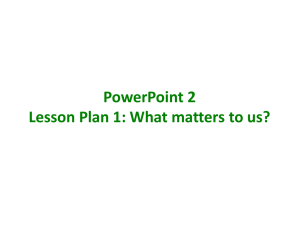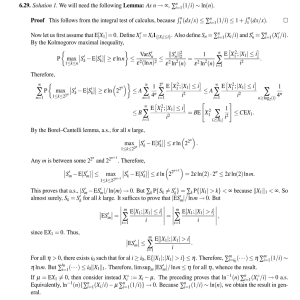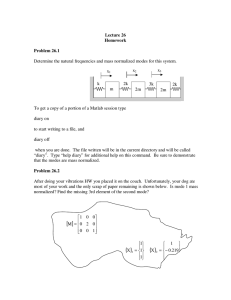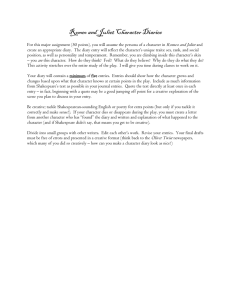Design Process-- Representing September 11, 2007 Turn in your Conceptual Map
advertisement
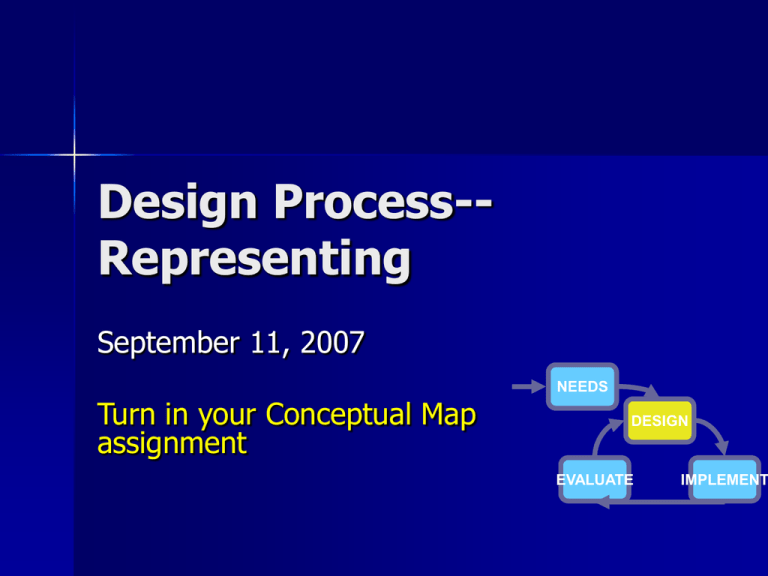
Design Process-Representing September 11, 2007 Turn in your Conceptual Map assignment NEEDS DESIGN EVALUATE IMPLEMENT Idea Commercials Materials for projection by midnight tonight! – Email to btsao@berkeley.edu – [cs160] in Subject line Presented in discussion section tomorrow – I’m planning to attend facebook application review Resources for finding interesting applications – http://www.insidefacebook.com/category/ applications/ – http://www.techdigest.tv/2007/07/the_10 1_best_fa.html – http://www.bestfacebookapplications.com/ Today Social software / facebook followup Understanding users, a few more techniques – Diary study – Experience Sampling Method – Personas Design, representing ideas – Scenarios – Storyboard – Role-playing Social software followup Wikipedia – How many people use Wikipedia? – How many people have contributed to Wikipedia? Demonstration of “social leveraging” Why does Wikipedia work? Virtual economy Point system, currency – Rewards for valued activities – Amount of “interaction time” Transform points social status – Visible markers – Acknowledge leaders – Exploit scarcity Finding right balance of money supply Social networking MySpace – 200M users – Focuses on music interests facebook – 39M users – Photo sharing LinkedIn – 14M users – Oriented toward professional networking, hiring Viral invitations, interoperability About the facebook platform After 3 months – 3,261 applications vetted by facebook – 46 applications attracted > 1M installs Platform is still evolving – We may experience change along the way Server support facebook project ideas Photos Games Shared Interests Productivity Location sharing Finding employment / grad school Mashups Meta-comment Mostly describing a variety of tools – Exercised a few in assignments – Will need to pick appropriate ones to apply in group project Grasp of tools tested in midterm Group project pulls threads of class together Additional observation tools Diary study Experience Sampling Method Personas Diary study Asking people to keep a diary of their interactions with a computer system, any significant events or problems during their use of a system, or other aspects of their working life – Record the date and time of an event – Where they are – Information about the event of significance – Ratings about how they feel, etc. Diary study variations Vocally recording diary entries – Give them recording device (iPod + mic) – Attach list of questions to device Use cell phone to call recording service to capture entries Why use a diary study? For situations that don’t afford direct observation – Occur infrequently – In dispersed settings – Additional observers awkward Collects data from actual experience Collecting data over longer time span Example: When do you think of communicating with your family? Diary study constraints Requires high incentives for participants – Reminder prompts – Reward per entry Self-reporting mechanism Access to recording instrument Palen & Salzman, “Voice-mail diary studies for naturalistic data capture under mobile conditions” http://doi.acm.org/10.1145/587078.587092 Experience Sampling Method (ESM) Getting user reactions in the moment Also known as Ecological Momentary Assessment (EMA) From psychology ESM Participant asked to carry “beeper” When beeper activates – Fill out short survey (using device) User’s context Reaction to stimulus Programmed alerts at “random” times – Several times / day over a week – Scope time intervals appropriately (i.e., awake hours) Large enough users, samples model ESM resources Open source tool for ESM – http://web.media.mit.edu/~intille/caes/ – http://seattleweb.intelresearch.net/projects/esm/ Kellogg et al., “I’d be overwhelmed, but it’s just one more thing to do” – http://doi.acm.org/10.1145/503376.503394 Why use ESM? “Ecological validity” of data – Better than retrospective self-report Deals with mobile activities (ubicomp) Captures reactions in context – Spatial – Situational – Temporal Collecting data over longer time span (beyond a single session or observation) Example: When do you answer cell phone? ESM constraints It is interruptive – Strategy for handling “non-response” Survey must be extremely quick to fill out – Less than 1 minute Personas Archetypal users that represent the needs of larger groups of users, in terms of their goals and personal characteristics Representing user research Guide vision and design Popularized by Alan Cooper – The Inmates are Running the Asylum – http://www.cooper.com/insights/journal_of_design/articles/ the_origin_of_personas_1.html Creating personas Name Demographic info Picture Paragraph descriptions – – – – User motivations Goals Expectations Personality Imaginary but precise, specific but stereotyped http://www.infotoday.com/Online/jul03/head.shtml Course Scheduler example persona Course Scheduler example persona Thanks to Prof. Marti Hearst Remember Jim? What were his good attributes? – Great looks – Witty stories – Good listening skills Personas anecdotes Sun Microsystems life-size cutouts of real customers – Sun’s customers otherwise “remote” – Get to know the customer “Customer” cutouts became jokes One customer actually visited in person! The Transformation of Kimberly Washington A persona for the development team Kimberly began her persona life… – Late 30s, master’s degree in technical discipline – Plump, African American – Engineers were not interested Kimberly’s persona was transformed… – Early 20s, Bachelor's degree in humanities – Slender, white, blonde Designing for yourself designing for your fantasy Thanks to Michael Muller, IBM Research Design, Representing Ideas Scenarios Storyboards Role-playing Scenarios Providing context for use (narrative) – Sometime referred to as “use cases” Narrative description of: – User(s) – Resources (tools, information, people) – Goal – Circumstances – Time interval Gas-pumping scenario – User(s) Driver, passenger – Resources (tools, information, people) Car, pump, currency, gas station attendant – Goal Fill up car with appropriate gas – Circumstances Day / night, sunny / rainy, leisurely / hurried – Time interval As quickly as possible Storyboarding Series of frames depicting key steps in reaching a goal – Mechanically, can use pin board for easy rearrangement / editing Describe the interaction in context – Show user in at least 1st frame (establishing shot) – User and the environment – User and the system That sounds like comics OK/Cancel February 3, 2006, http://www.ok-cancel.com/comic/125.html The value of comics Juxtaposed pictorial images in a deliberate sequence; “sequential art” – Abstraction allows personal projection into the scene – Our sense of closure fills in the missing details Magic of closure Storyboard examples Film editing interface Posting storyboards on flickr Testing storyboards with users Using storyboards to get input from users, other stakeholders Check understanding of process that users go through – Observe user reaction – Debrief users Good reference point for design process Storyboarding hints Keep it quick Cleverly re-use cards and copying – Draw large window – Draw components on cards – Rearrange cards, copy Allows trying out ideas without writing any code Storyboarding exercise Storyboard the process of adding a cameraphone picture to facebook photos – Last time focused on drawing – This time, focused on designing and expressing ideas – What are the steps? Features? – 15 minutes Reflecting on storyboarding Features? – Email, text, designated email Steps? Role-playing Enacting scenarios, storyboards Recording on video – Presentations – Publicity Video records (showing up on YouTube) – – – – Microsoft Surfaces (2007) http://www.youtube.com/watch?v=QigsOR9r36k Apple Knowledge Navigator (1987) http://youtube.com/watch?v=3WdS4TscWH8 Bodystorming Transformation of abstract ideas and concepts into physical experiences Imagining the product already exists – Act as if it exists – In the context of how you would use it – Involving entire body in enacting usage Oulasvirta et al., “Understanding contexts by being there: Case studies in bodystorming” – http://dx.doi.org/10.1007/s00779-003-0238-7 Assignment (Due Sept. 13) Forming project teams (4 people) – Submit list of names + email in group (1 per group) OR – Name, email, plus list of interests to help form group Especially important to participate in section Visually annotated idea list Next time Readings – Norman, DOET, Chapter 2 – First Principles of Interaction Design (from AskTog)



